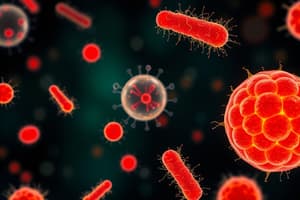Podcast
Questions and Answers
What is the purpose of mould on some salamis?
What is the purpose of mould on some salamis?
- To add flavor
- To lower the pH
- For protection (correct)
- To change the texture
In which region is fermented herring commonly eaten?
In which region is fermented herring commonly eaten?
- Scandinavian countries (correct)
- Central Asia
- The UK
- East Asia
What type of bacteria is used to ferment kimchi?
What type of bacteria is used to ferment kimchi?
- Acetic acid bacteria
- Bacteria (correct)
- Mould
- Yeast
How is sauerkraut typically made?
How is sauerkraut typically made?
What is a common use of fermentation in condiments and sauces?
What is a common use of fermentation in condiments and sauces?
What type of microorganisms are responsible for fermenting sugars and starches in bread?
What type of microorganisms are responsible for fermenting sugars and starches in bread?
What is typically used to make vinegar?
What is typically used to make vinegar?
What is the result of bacteria fermentation in pickles?
What is the result of bacteria fermentation in pickles?
What is the purpose of bacteria in cheese production?
What is the purpose of bacteria in cheese production?
What is typically destroyed to create yeast extracts?
What is typically destroyed to create yeast extracts?
What is the role of microorganisms in yogurt production?
What is the role of microorganisms in yogurt production?
What is the main purpose of yeast fermentation in the production of alcoholic drinks?
What is the main purpose of yeast fermentation in the production of alcoholic drinks?
What is the purpose of bacteria in wine production?
What is the purpose of bacteria in wine production?
What type of microorganisms are used to make soy sauce?
What type of microorganisms are used to make soy sauce?
What is the main difference between tempeh and miso paste?
What is the main difference between tempeh and miso paste?
What is the common feature among kefir, yogurt, and cheese production?
What is the common feature among kefir, yogurt, and cheese production?
What is the primary function of yeasts in kombucha production?
What is the primary function of yeasts in kombucha production?
What is the typical base ingredient used to make kvass?
What is the typical base ingredient used to make kvass?
What is the primary purpose of fermenting cocoa beans in chocolate production?
What is the primary purpose of fermenting cocoa beans in chocolate production?
What is mycoprotein created from?
What is mycoprotein created from?
What is the main category of hazards that includes bacteria and molds?
What is the main category of hazards that includes bacteria and molds?
What is the result of fermenting sugars in kombucha production?
What is the result of fermenting sugars in kombucha production?
What is the primary purpose of predictive microbiology in food safety?
What is the primary purpose of predictive microbiology in food safety?
What is the name of the process that destroys the unwanted seed coating of cocoa beans?
What is the name of the process that destroys the unwanted seed coating of cocoa beans?
What is the main goal of studying food microbiology?
What is the main goal of studying food microbiology?
Who is credited with developing canning as a method of food preservation?
Who is credited with developing canning as a method of food preservation?
What is the primary role of microorganisms in food production?
What is the primary role of microorganisms in food production?
When did the concept of 'food poisoning' become recognized?
When did the concept of 'food poisoning' become recognized?
What is the primary role of yeasts in bread making?
What is the primary role of yeasts in bread making?
Why are some microorganisms undesirable in food production?
Why are some microorganisms undesirable in food production?
What is the name of the process by which microorganisms convert sugars to produce ethanol and carbon dioxide?
What is the name of the process by which microorganisms convert sugars to produce ethanol and carbon dioxide?
What is the estimated date of beer production?
What is the estimated date of beer production?
Flashcards
Salami Mould
Salami Mould
A type of mould used for protection on some salamis.
Fermented Herring Region
Fermented Herring Region
Scandinavian countries are known for eating fermented herring.
Kimchi Fermentation
Kimchi Fermentation
Kimchi is fermented using bacteria.
Sauerkraut Production
Sauerkraut Production
Signup and view all the flashcards
Fermentation in Sauces
Fermentation in Sauces
Signup and view all the flashcards
Bread Fermentation
Bread Fermentation
Signup and view all the flashcards
Vinegar Production
Vinegar Production
Signup and view all the flashcards
Pickle Fermentation
Pickle Fermentation
Signup and view all the flashcards
Bacteria in Cheese
Bacteria in Cheese
Signup and view all the flashcards
Yeast Extract Production
Yeast Extract Production
Signup and view all the flashcards
Microorganisms in Yogurt
Microorganisms in Yogurt
Signup and view all the flashcards
Ethanol Production
Ethanol Production
Signup and view all the flashcards
Bacteria in Wine
Bacteria in Wine
Signup and view all the flashcards
Soy Sauce Microorganisms
Soy Sauce Microorganisms
Signup and view all the flashcards
Tempeh vs Miso
Tempeh vs Miso
Signup and view all the flashcards
Yogurt, Kefir, and Cheese
Yogurt, Kefir, and Cheese
Signup and view all the flashcards
Kombucha Yeasts
Kombucha Yeasts
Signup and view all the flashcards
Kvass Base Ingredient
Kvass Base Ingredient
Signup and view all the flashcards
Cocoa Bean Fermentation
Cocoa Bean Fermentation
Signup and view all the flashcards
Mycoprotein Origin
Mycoprotein Origin
Signup and view all the flashcards
Biological Hazards
Biological Hazards
Signup and view all the flashcards
Kombucha Fermentation Result
Kombucha Fermentation Result
Signup and view all the flashcards
Predictive Microbiology
Predictive Microbiology
Signup and view all the flashcards
Cocoa Bean Seed Coating Removal
Cocoa Bean Seed Coating Removal
Signup and view all the flashcards
Food Microbiology Goal
Food Microbiology Goal
Signup and view all the flashcards
Canning Inventor
Canning Inventor
Signup and view all the flashcards
Microorganisms in Food Production
Microorganisms in Food Production
Signup and view all the flashcards
Food Poisoning Recognition
Food Poisoning Recognition
Signup and view all the flashcards
Yeast in Bread Making
Yeast in Bread Making
Signup and view all the flashcards
Undesirable Microorganisms
Undesirable Microorganisms
Signup and view all the flashcards
Fermentation Process
Fermentation Process
Signup and view all the flashcards
Beer Production Date
Beer Production Date
Signup and view all the flashcards
Study Notes
History of Food Microbiology
- Early food preservation: 900 AD - "Food Poisoning" recognized
- 1795 - Appert developed canning
- 1854-1864 - Food Microbiology becomes a science, thanks to Louis Pasteur
Importance of Food Microbiology
- Provide clean, safe, healthful food to consumers
- Control microbial growth to prevent food spoilage and food-borne illnesses
- Preserve and produce food using microorganisms
Microorganisms in Food Production
- Bacteria, viruses, and fungi (yeasts and molds) are microorganisms used in food production
- Some microorganisms are undesirable, causing spoilage or illness, while others are used to make food
- History of microorganism use in foods: cheese, yogurt, bread, wine, and beer production
Microorganisms in Food
- Microorganisms are used to make cheese, yogurt, and bread
- Yeasts are used in bread production to ferment sugars and produce carbon dioxide
- Lactic acid bacteria are used in sourdough bread to provide a sour taste
- Moulds are used in blue cheese production to give it a unique characteristic
- Bacteria are used in yogurt production to thicken milk and provide a sour taste
Fermented Foods
- Soy-based products: soy sauce, miso soup, tempeh, and fermented meat and fish products
- Fermented vegetables: kimchi, sauerkraut, pickled gherkins, and condiments like yeast extract, Worcestershire sauce, and hot sauce
- Drinks: kombucha, kvass, and vinegar
- Mycoprotein: a meat alternative made from fungus
- Chocolate: fermented cocoa beans are used to make chocolate
Food Safety
- Food safety is divided into three categories: biological, chemical, and physical hazards
- Indicators of food microbial quality and safety: predictive microbiology and microbial modeling
Studying That Suits You
Use AI to generate personalized quizzes and flashcards to suit your learning preferences.
Description
This quiz covers the basics and importance of food microbiology, including its history, importance of studying microbiology, and its applications in ensuring food safety and quality.




